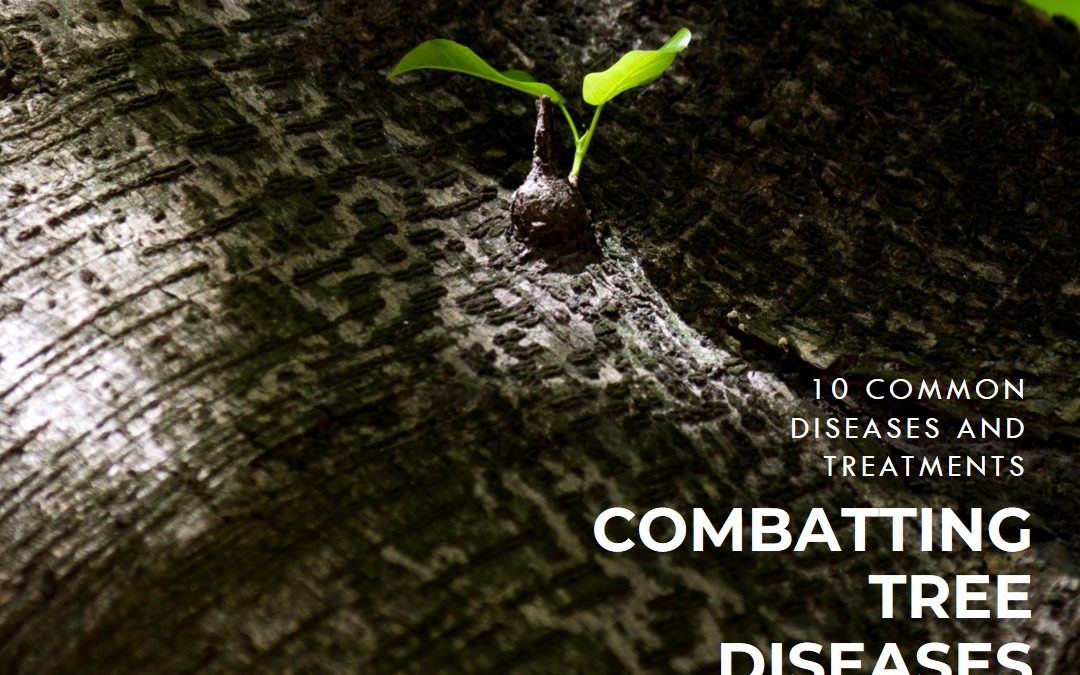Tree diseases can be caused by fungal, bacterial, and viral pathogens, leading to leaf spot diseases, root rots, and cankers. Addressing these diseases involves accurate diagnosis and tailored treatment strategies, including fungicide applications and proper tree care practices.
Understanding common tree diseases and their treatments is essential for maintaining healthy landscapes.
1. Leaf Spot Diseases
Leaf spot diseases are caused by fungal pathogens, leading to leaf-discolored spots. Although they do not threaten the tree’s life. Treatment involves applying fungicides and removing fallen leaves to reduce the spread of the disease.
2. Root Rots
Root rots are severe diseases affecting the tree’s roots, often caused by fungi such as Phytophthora. Symptoms include wilting, yellowing leaves, and reduced growth. Treatment requires improving drainage, avoiding overwatering, and, in some cases, applying fungicides.
3. Cankers
Cankers are localized dead areas on the bark, stems, branches, or twigs caused by fungal or bacterial pathogens. To treat, prune out the infected parts during dry weather to prevent spread, and apply a suitable fungicide if necessary.
4. Powdery Mildew
Powdery mildew presents a white or gray powdery growth on leaves and stems caused by fungal infection. It’s treated by improving air circulation around the tree and applying fungicides that target the specific pathogen.
5. Apple Scab
Specific to apple and crabapple trees, apple scab causes dark, scab-like lesions on leaves and fruit. Management includes resistant tree varieties, timely fungicide applications, and cleanliness around the tree base.
6. Fire Blight
Fire blight is a bacterial disease that affects fruit trees like apples and pears, causing a burnt appearance on branches. Treatment involves pruning the infected branches well below the damaged area and applying bactericides.
7. Dutch Elm Disease
Caused by a fungus spread by elm bark beetles, Dutch elm disease leads to wilting and yellowing of leaves. Preventative measures include injecting trees with fungicides and removing infected trees to prevent spread.
8. Oak Wilt
Oak wilt is a fungal disease that blocks the water-conducting vessels of oak trees, leading to leaf discoloration and tree death. Management includes preventing wounds that could invite infection, removing infected trees, and injecting healthy trees with a fungicide.
9. Verticillium Wilt
Verticillium wilt affects a wide range of trees, causing wilting and death of branches. There’s no cure, but you can prolong the life of infected trees through proper care, including watering, mulching, and fertilizing.
10. Cedar Rusts
Cedar rusts are fungal diseases that require two hosts, an apple and a cedar or juniper, to complete their life cycle. Management includes removing the alternate host, applying fungicides, and choosing resistant varieties.
Prevention and Treatment Strategies
Preventing and treating tree diseases requires strategies to keep trees healthy and manage problems as they arise.
From prevention through selecting disease-resistant varieties and proper care to accurate diagnosis and choosing the right treatment, every step is crucial in ensuring the health and longevity of trees.
Prevention is Key
Preventing tree diseases involves selecting disease-resistant tree varieties, proper planting techniques, and ensuring optimal growing conditions to reduce stress on the trees.
Regular monitoring and maintenance, such as pruning and clean-up of fallen debris, can also help prevent the spread of pathogens.
Accurate Diagnosis
Before any treatment is applied, it’s crucial to diagnose the problem. Misdiagnosis can lead to ineffective treatment and further stress on the tree. If unsure, consulting with a professional arborist or a plant pathologist is advisable.
Choosing the Right Treatment
Once the disease is identified, the appropriate treatment can be selected. This might involve chemical treatments, such as fungicides or bactericides, or cultural practices, such as improving soil drainage or air circulation around the tree.
In some cases, especially with severe infections, removing the affected tree may be the best course of action to prevent the spread of disease to nearby healthy trees.
Regular Care and Maintenance
Caring for trees by watering, mulching, and fertilizing as needed can reduce their susceptibility to diseases. Stressed trees are more likely to become infected, so maintaining a tree’s health is critical to disease prevention.
Conclusion
Tree diseases can have a profound impact on tree health and longevity. By understanding the common diseases and their treatment options, tree owners can take proactive steps to protect their trees and ensure they continue to thrive for years.
Healthy trees are less susceptible to diseases, so good tree care practices are essential for disease prevention.


